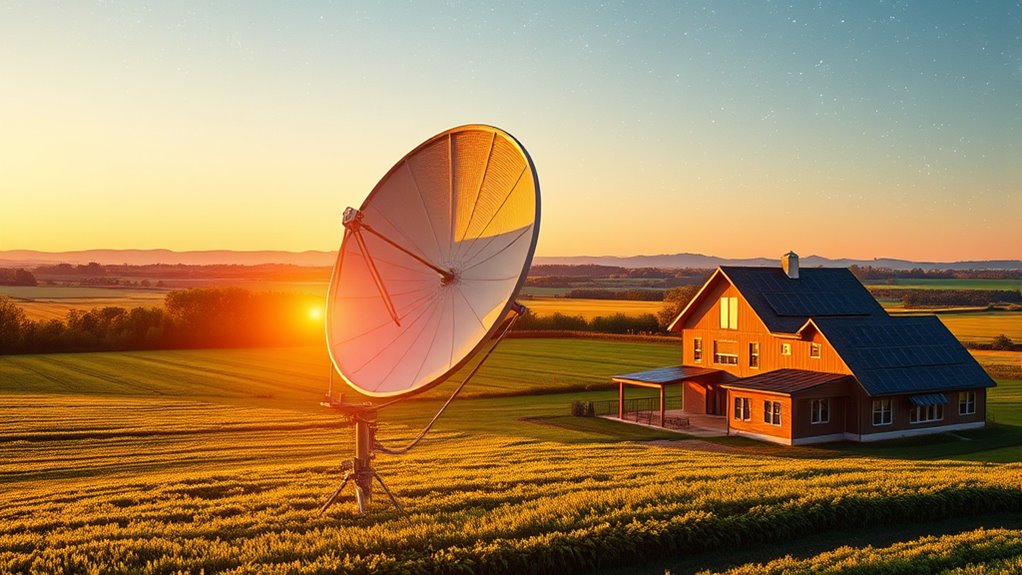Satellite internet provides reliable coverage in remote areas by using space-based technology, making it ideal where ground infrastructure is limited. It offers speeds up to 220 Mbps, but weather and environmental factors can cause disruptions. Costs vary, with options for unlimited data and no contracts, while recent innovations like LEO satellites and phased array antennas are boosting speed and coverage. If you’re curious about how these advances shape the future of connectivity, you’ll find plenty more to explore.
Key Takeaways
- Pros include wide coverage in remote areas, quick deployment, and improved speeds with innovations like LEO satellites.
- Cons involve weather-related disruptions, higher latency compared to wired connections, and equipment costs.
- Future coverage will expand with large satellite constellations, mesh networks, and advanced antenna technology enhancing reliability.
- Satellite internet bridges the digital divide by providing connectivity in underserved regions, supporting education and healthcare.
- Ongoing technological advancements aim to reduce latency, increase speeds, and lower costs, making satellite internet more accessible worldwide.
How Satellite Internet Reaches Remote Areas

Satellite internet reaches remote areas by providing coverage where traditional wired connections can’t. All you need is a clear view of the sky and a satellite dish to get started. Unlike cable or DSL, it doesn’t rely on extensive ground infrastructure, making it it ideal for isolated regions. The system operates independently of cell towers and land-based networks, expanding access to even the most rural locations. Installation involves setting up a satellite dish, which a professional technician typically handles within a few days. The dish communicates with geostationary satellites orbiting high above, ensuring consistent service over large areas. Proper preparation and maintenance of the equipment can help optimize performance and longevity. Additionally, advancements in antenna technology are continuously improving connection quality and speeds. These technological improvements, coupled with improved satellite coverage, are making satellite internet increasingly reliable and accessible for remote communities. As a result, many remote communities are seeing expanded connectivity that bridges the digital divide. This setup allows remote communities to connect to the internet without needing extensive physical infrastructure, bringing much-needed connectivity to places previously out of reach. Furthermore, ongoing innovations in satellite network architecture are expected to enhance reliability and reduce latency, further benefiting users in remote areas.
The Speed and Data Cap Dynamics of Satellite Service

The speed and data cap dynamics of satellite internet vary widely depending on the provider, technology, and your location. You can expect download speeds from 25 to 220 Mbps, with newer options like Starlink delivering higher speeds than traditional providers such as HughesNet or Viasat. Your geographical location influences speed due to signal degradation and satellite coverage. If you surpass data limits, your speeds may slow down, especially with soft caps, or you might face additional charges with hard caps. Data plans range from 10 GB to unlimited, but many providers impose soft caps around 850 GB per month. These limits can hinder activities like streaming or video calls, and exceeding them often results in throttled speeds or extra fees, affecting your overall experience. Additionally, the types of headphone jacks you choose can impact your device compatibility and audio quality. The coverage areas of satellite internet are continually expanding as technology advances, making it a more viable option for rural and underserved communities. As the technological advancements that improve satellite connectivity evolve over time, so does the understanding of community integration, which can also be relevant when considering technology adoption and community integration.
Weather and Environmental Factors Affecting Connectivity

Weather and environmental conditions can substantially impact your satellite internet connection. Heavy rain, snow, and thunderstorms cause signal disruptions, leading to slow speeds or total outages. Moisture in the atmosphere weakens signals, reducing performance, while severe weather like hail can physically damage dishes. Thick cloud cover and fog also attenuate signals, with prolonged cloud cover causing extended issues. Snow accumulation on dishes blocks signals, and heavy snowfall or blizzards can cause significant disruptions. During storms, lightning and high winds may misalign or damage equipment, and hurricanes or tornadoes can destroy satellite setups altogether. To combat these effects, providers often increase signal power, utilize weather-resistant hardware, and implement redundant systems. Despite these measures, extreme weather remains a key factor influencing satellite internet reliability. Additionally, store hours for local providers can affect when troubleshooting or support services are available, which may impact timely resolution during adverse weather conditions. Proper weather-resistant hardware and strategic dish placement can also help mitigate some environmental impacts, ensuring more consistent connectivity. Furthermore, understanding environmental impact helps users to better prepare and safeguard their equipment against unpredictable conditions, as well as consider the importance of regular maintenance for optimal performance. Investing in protective enclosures can further shield equipment from harsh weather elements, enhancing durability and uptime.
Comparing Costs and Contract Terms in Satellite Plans
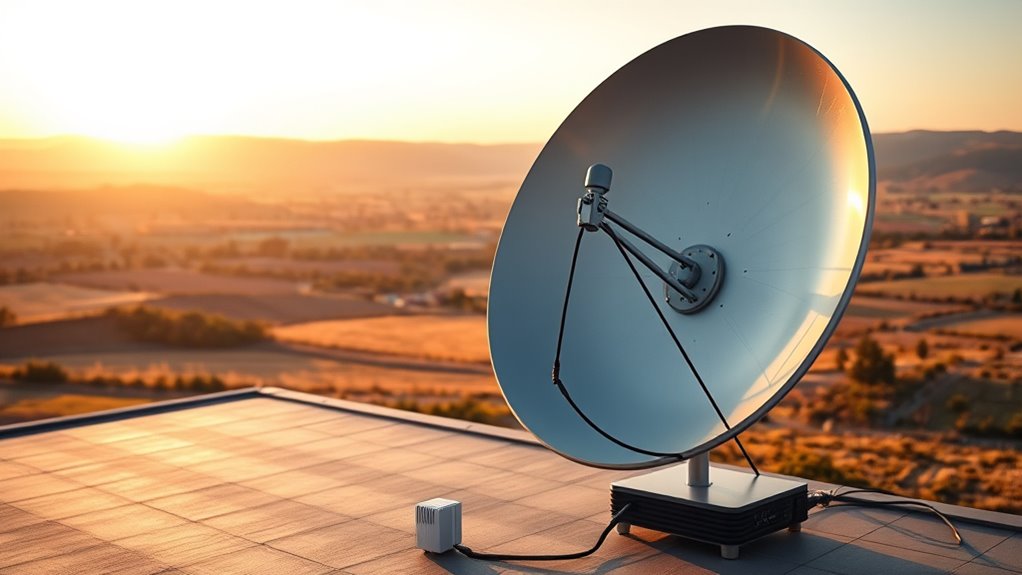
Understanding the costs and contract terms of satellite internet plans can help you choose the best option for your needs. Prices vary considerably: Starlink charges between $90 and $120 monthly, with a one-time equipment fee of $349. Hughesnet costs from $49.99 to $94.99, offering 50–100 Mbps speeds, often with a two-year contract. Viasat’s plans range from $99.99 to $129.99, providing up to 100 Mbps and options for equipment purchase or rental. Most providers have data caps—Hughesnet with limited allowances, Viasat with unlimited data but throttling after thresholds, and Starlink offering unlimited data but prioritizing certain users. Contract flexibility differs: Starlink has no contracts, while Hughesnet and Viasat typically require commitments with early termination fees. Additionally, the effectiveness of satellite internet can be influenced by factors such as signal stability, which is affected by weather conditions, geographic location, and network congestion, impacting overall performance and user experience. External factors like building placement and surrounding structures can also influence signal quality, making proper setup essential. Moreover, equipment installation plays a crucial role in optimizing signal strength and reliability, emphasizing the importance of proper placement and adjustments. These factors can also be influenced by home decor elements, such as placement of equipment and surrounding structures, which can affect signal quality.
Technological Innovations Enhancing Satellite Internet
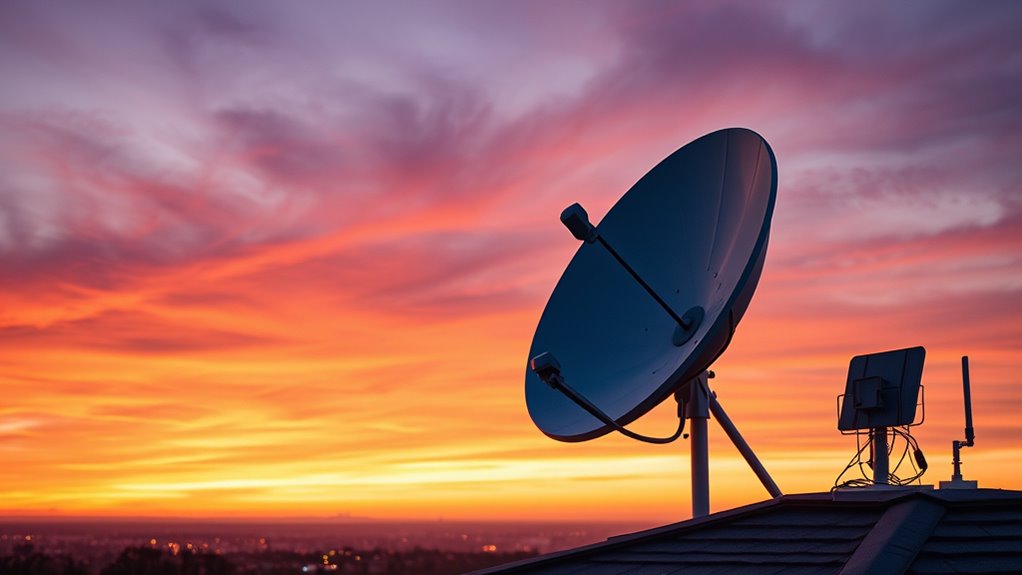
Have you ever wondered how satellite internet is becoming faster and more reliable? Advances like Low Earth Orbit (LEO) satellites orbit at lower altitudes, reducing latency and boosting speeds. SpaceX’s Starlink, the largest LEO constellation, supports streaming and online activities, expanding coverage worldwide. Very High-Throughput Satellites (VHTS) push speeds between 25Mbps and 150Mbps, rivaling traditional internet. Inter-satellite laser communication forms a mesh network, increasing data transfer rates. Modern infrastructure improvements include mesh networks, satellite constellations, and compact equipment that’s easier to deploy. Hardware innovations like more efficient designs, higher throughput, and lower power consumption extend satellite lifespan and performance. These breakthroughs provide lower latency, faster data, and reliable service, especially in remote areas, making satellite internet more practical and accessible than ever. Additionally, ongoing research into space-based infrastructure and satellite network optimization aims to further enhance coverage and connectivity worldwide.
The Role of Satellite Internet in Bridging the Digital Divide

Satellite internet plays a crucial role in bridging the digital divide by making connectivity accessible in remote and underserved regions where terrestrial infrastructure is impractical or too costly to deploy. Its cost-effective deployment bypasses the need for extensive ground infrastructure, making it ideal for deserts, jungles, and mountains. Governments often partner with providers to subsidize terminals, ensuring affordability for low-income areas. Competition among providers like Starlink and OneWeb helps drive down prices, reducing urban-rural inequality. Satellite solutions also reduce dependency on unreliable power grids through solar-compatible terminals. Rapid deployment allows you to access the internet faster than traditional fiber projects. By addressing infrastructure gaps and offering scalable, adaptable solutions, satellite internet brings connectivity to regions previously cut off, helping bridge the digital divide effectively. Additionally, satellite technology is continually evolving, with advancements in coverage expansion promising even greater reach in the future. Moreover, innovations in signal reliability are enhancing connection stability, making satellite internet a more dependable option for users worldwide. The ongoing development of antenna technology further improves data transmission efficiency, supporting higher speeds and lower latency.
Impact on Education and Healthcare Sectors
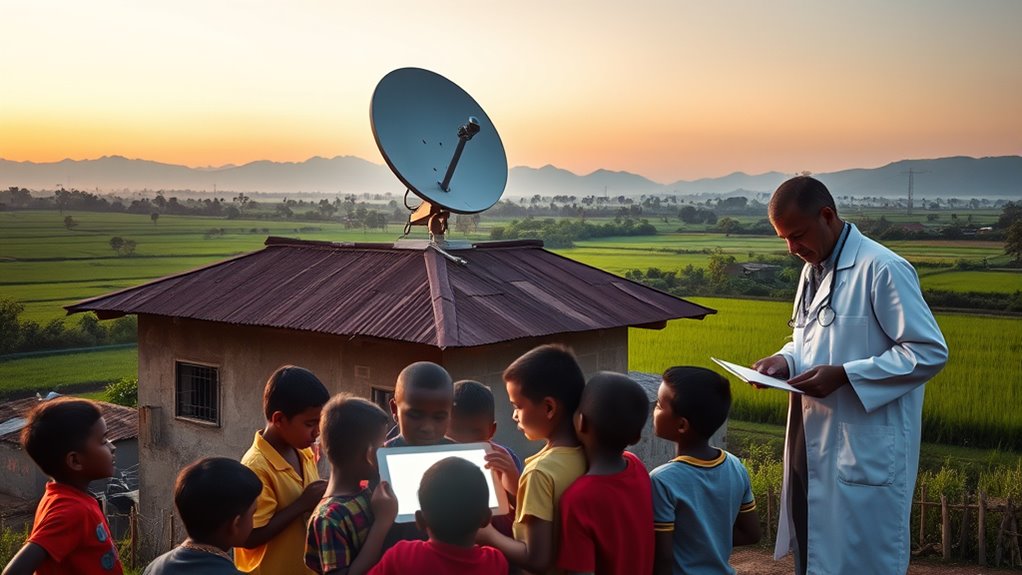
Satellite internet remarkably transforms education and healthcare in remote areas by providing reliable connectivity where traditional infrastructure falls short. It enables the direct delivery of updated educational content to local servers, ensuring students access modern materials without continuous internet. Offline educational resources on school premises get refreshed via satellite, helping teachers stay current with digital tools. Partnerships with companies like Eutelsat and Ed4free demonstrate how satellite communications empower educators in disconnected regions. In healthcare, satellite connectivity supports telehealth services, remote diagnostics, and consultations, reducing travel needs and improving outcomes. It also allows healthcare providers to access updated information and training, enhancing care quality. Additionally, satellite internet facilitates infrastructure development, which is essential for long-term community growth. Overall, satellite internet bridges gaps, fostering equitable access to education and healthcare, and strengthening community well-being in underserved areas.
Challenges for Gaming and Streaming Enthusiasts

Playing and streaming games over satellite internet presents significant challenges due to inherent technical limitations. High latency from long signal travel causes noticeable input lag, which can ruin fast-paced games like shooters and multiplayer titles. You might notice delays between your actions and in-game responses, making precise gameplay difficult. Limited bandwidth and data caps further complicate things, especially when streaming high-definition gameplay or downloading updates. Exceeding data limits results in throttled speeds, disrupting your gaming sessions. Weather conditions such as heavy rain or storms can degrade signal quality, causing lag spikes or disconnections. These environmental factors, combined with satellite-specific delays, make stable, smooth gameplay and streaming nearly impossible at times. Overall, satellite internet hinders real-time gaming experiences and high-quality streaming, frustrating enthusiasts seeking seamless entertainment.
The Future of Satellite Coverage and Speed Improvements

Recent technological advancements are paving the way for significant improvements in satellite coverage and speed. Enhanced bandwidth from higher frequency bands like Ka- and V-band boosts data transmission rates, supporting faster internet. Inter-satellite laser links reduce dependence on ground stations, expanding coverage over oceans and remote areas. Phased array antennas are smaller and more practical, replacing bulky dishes for consumers. Signal processing improvements enable satellites to handle more connections simultaneously and adapt to changing conditions, reducing latency with LEO satellites reaching as low as 20-30 milliseconds. The deployment of large satellite constellations, like Starlink and Amazon’s Project Kuiper, rapidly expands global coverage. These innovations guarantee more reliable, high-speed connectivity, especially in underserved regions, making satellite internet a more viable and competitive option in the future.
The Growing Competition and Industry Developments
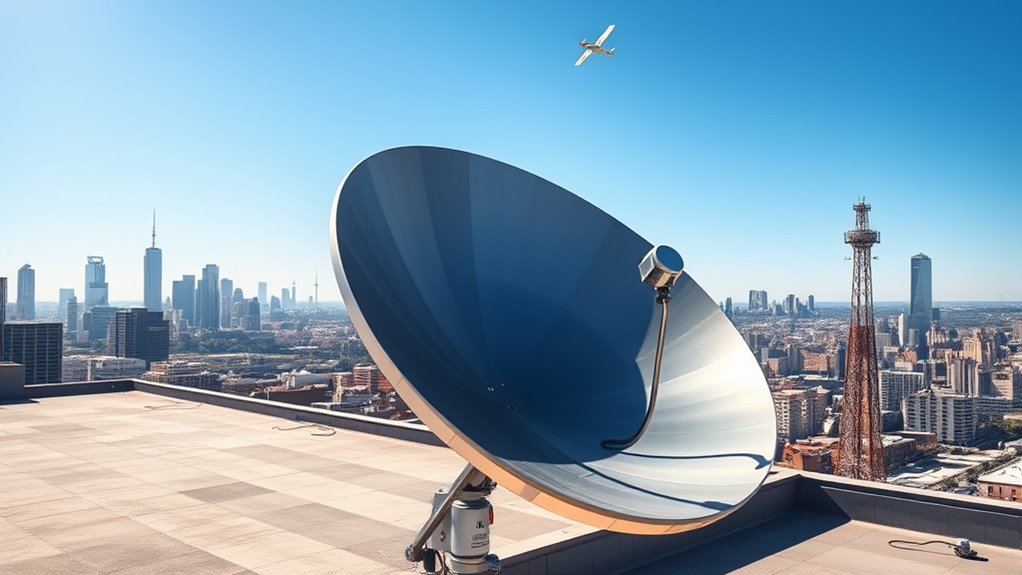
The satellite internet industry is experiencing rapid growth, driven by an increasing demand for reliable connectivity in remote and underserved areas. The market was valued at $5.1 billion in 2024 and is projected to hit $24.6 billion by 2030, with a CAGR of 11.2% from 2024 to 2025 and 14.9% by 2029. Major players like SpaceX’s Starlink, Amazon’s Project Kuiper, and OneWeb are expanding their constellations. These companies are deploying advanced LEO satellites, which offer high-speed, low-latency internet. Technological innovations, including integration with 5G and affordable terminals, are making satellite internet more competitive. As competition heats up, the industry aims to bridge the digital divide worldwide and serve sectors like agriculture, maritime, and emergency response.
Frequently Asked Questions
How Does Satellite Internet Compare to Fiber Optic in Terms of Latency?
When comparing satellite internet to fiber optic in regards to latency, you’ll find satellite signals take longer to travel due to space distance, often resulting in 600 ms or more delays. In contrast, fiber optic offers low latency, just milliseconds, making it ideal for real-time activities like gaming or video calls. While satellite is more available in remote areas, fiber provides faster, more reliable connections with considerably lower latency.
What Are the Environmental Impacts of Deploying Satellite Constellations?
You might think satellite constellations are a simple tech upgrade, but they impact Earth’s environment considerably. Increased launches contribute to greenhouse gases, stratospheric pollution, and climate change. They create space debris, risking collisions and the Kessler Syndrome, which could trap us on Earth. Plus, they cause light pollution that disrupts astronomy and cultural practices. Without proper regulation, these environmental risks could outweigh the benefits of broader connectivity.
Can Satellite Internet Be Used Effectively for Live Streaming Events?
You can use satellite internet effectively for live streaming events, especially in remote areas where traditional internet isn’t available. It offers reliable coverage, supports high-quality content, and can handle large audiences without infrastructure hassles. While latency and bandwidth can be challenges, technological advances are improving these issues. With the right equipment and plans, satellite internet can deliver smooth, high-definition live streams for your events.
How Secure Is Data Transmission Over Satellite Internet Networks?
Think of satellite internet like a modern fortress—your data’s security depends on its defenses. You benefit from strong encryption methods like AES-256 and secure protocols such as SSL/TLS. However, threats like interception, eavesdropping, and satellite hijacking still exist. To stay protected, you need robust cybersecurity practices, regular monitoring, and advanced threat detection. While secure, it’s essential to remain vigilant against evolving cyber threats in satellite networks.
What Are the Long-Term Plans for Global Satellite Internet Coverage Expansion?
Your concern about long-term plans for global satellite internet coverage is valid. Major players like Starlink aim to deploy thousands of satellites to achieve full worldwide coverage, especially in underserved areas. Amazon’s Project Kuiper and Eutelsat OneWeb are also expanding their constellations. These efforts, combined with advancements in satellite tech and strategic partnerships, aim to bridge coverage gaps, making internet access more reliable and widespread in the coming decades.
Conclusion
As satellite internet continues to evolve, you’ll find it shaping a world where connectivity transcends boundaries. Like a bridge spanning vast distances, it brings remote areas into the digital fold, yet challenges like weather and speed remain. Embrace the innovation, for in this landscape of progress, the future holds the promise of seamless access—reminding us that technology’s true power lies in uniting us all, no matter where we are.
